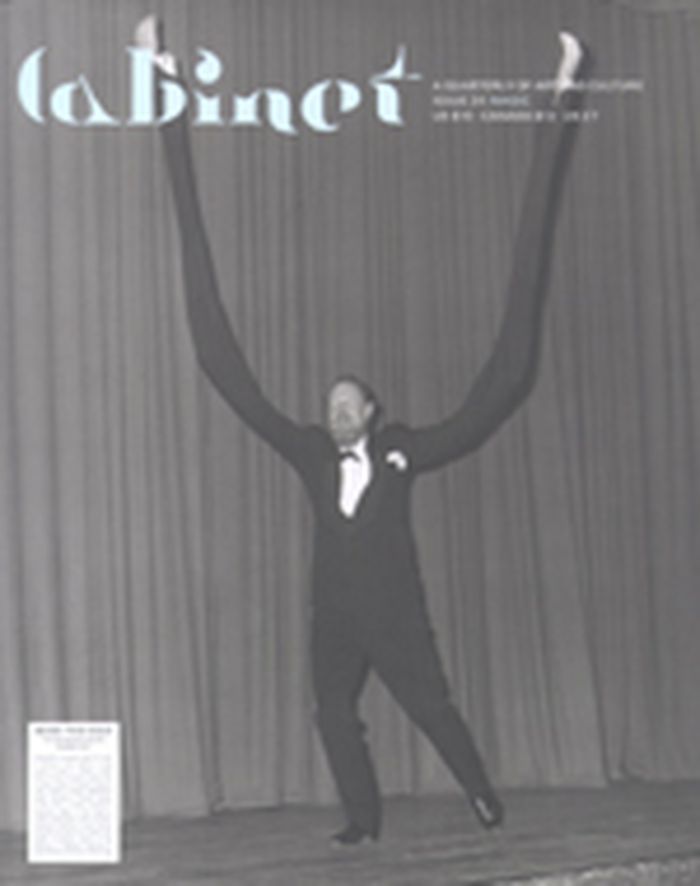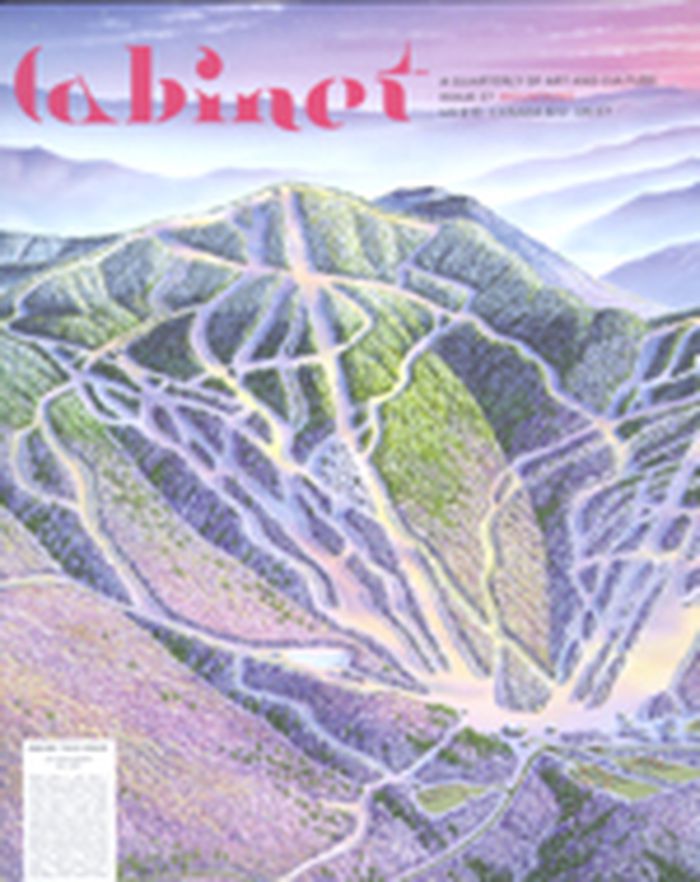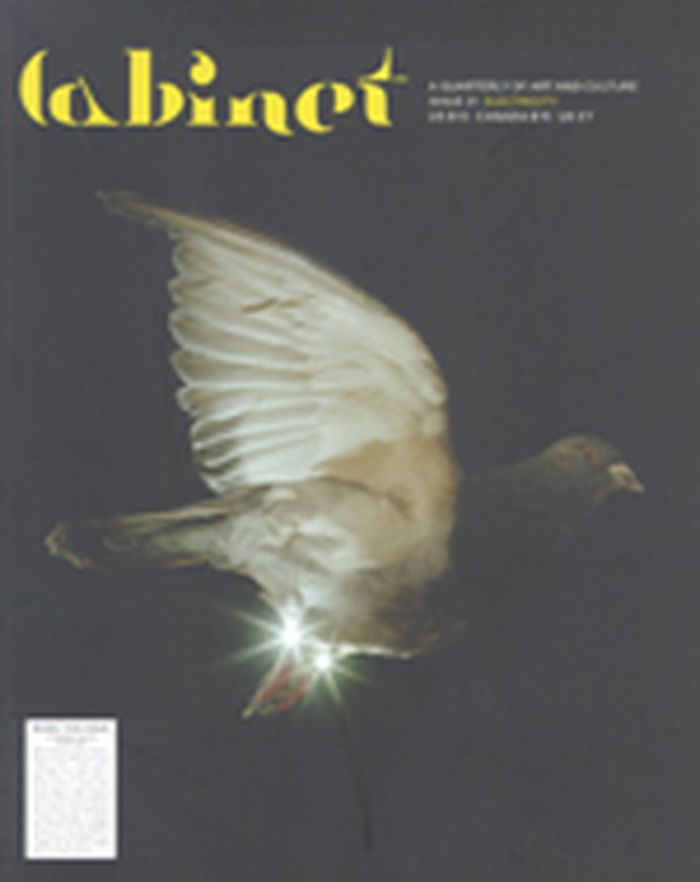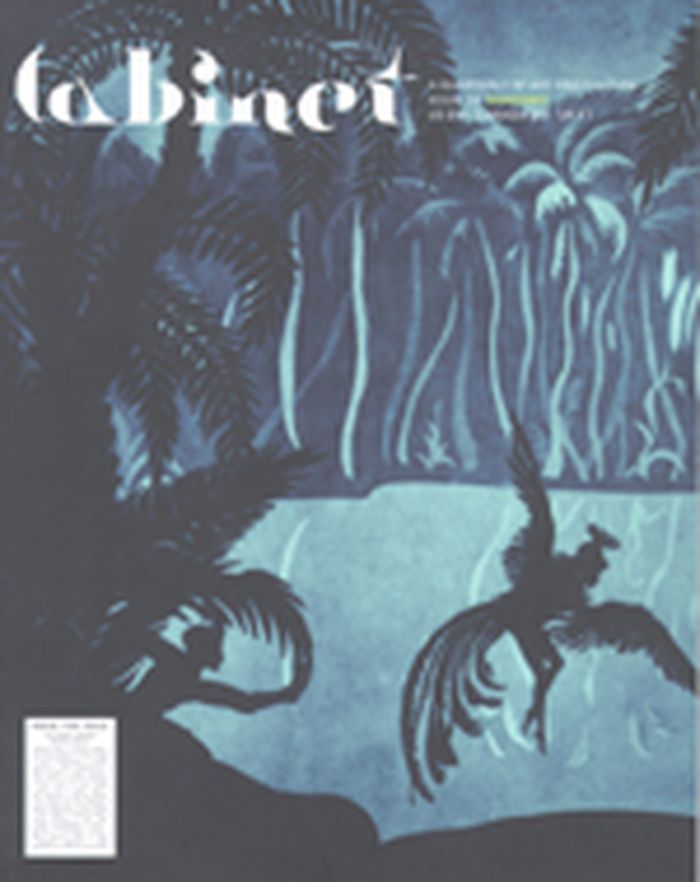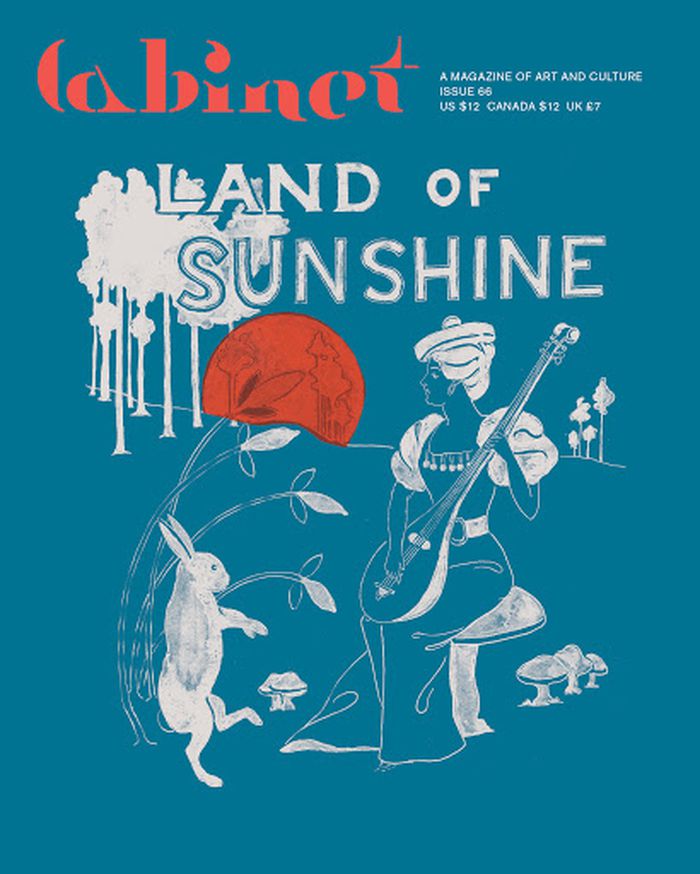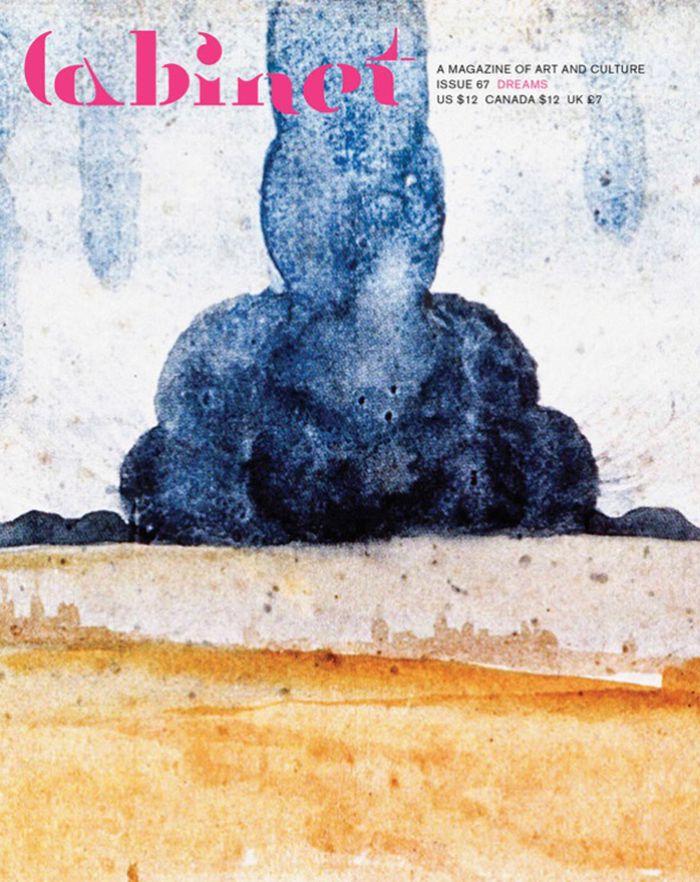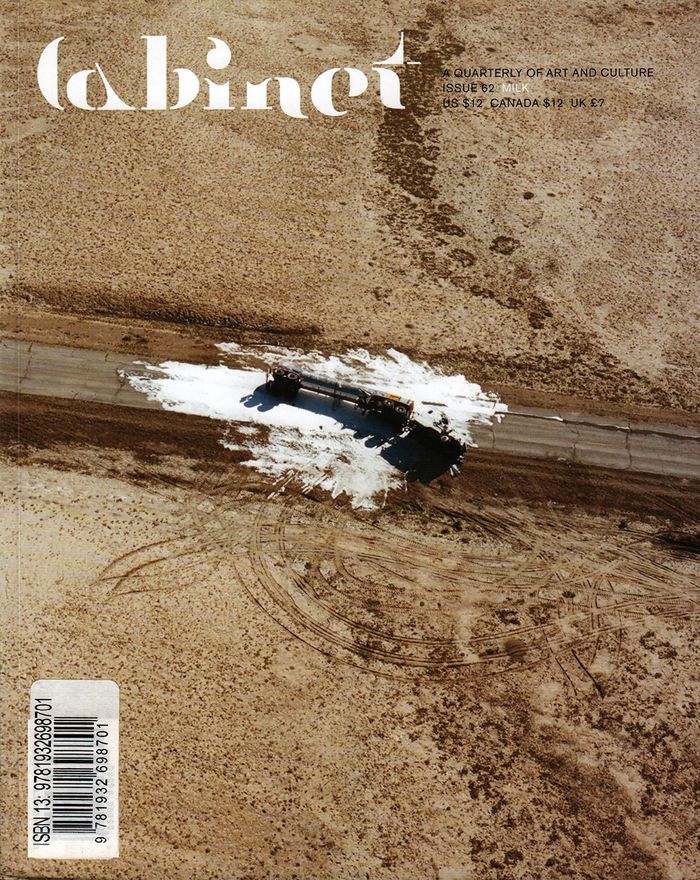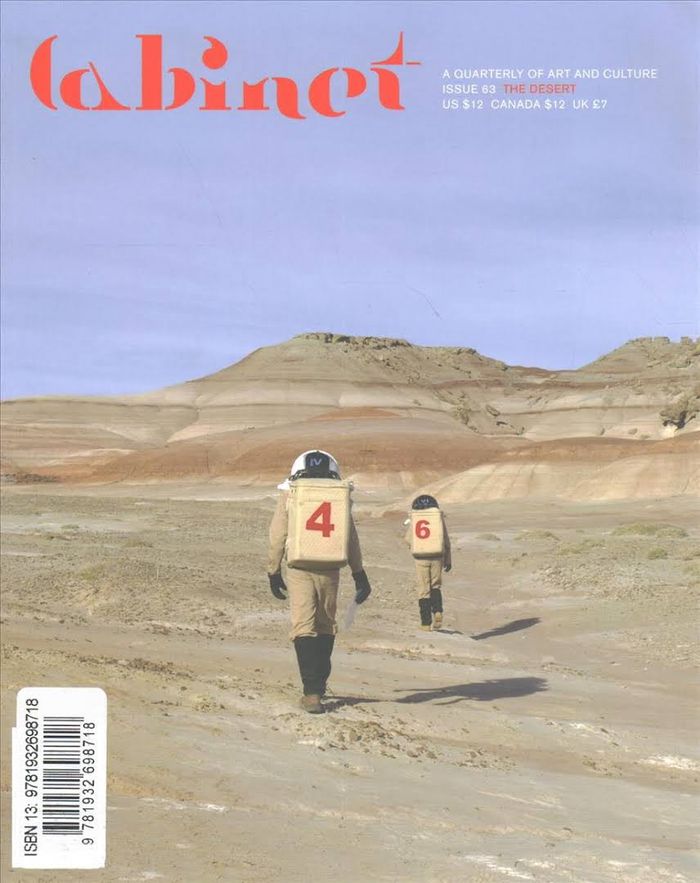journals and magazines
$11.00
(available to order)
Summary:
Cabinet is an award-winning quarterly magazine of art and culture that confounds expectations of what is typically meant by the words "art," "culture," and sometimes even "magazine." Like the 17th-century cabinet of curiosities to which its name alludes, Cabinet is as interested in the margins of culture as its center. Presenting wide-ranging, multi-disciplinary content(...)
Cabinet 16: the sea, winter 2005
Actions:
Price:
$11.00
(available to order)
Summary:
Cabinet is an award-winning quarterly magazine of art and culture that confounds expectations of what is typically meant by the words "art," "culture," and sometimes even "magazine." Like the 17th-century cabinet of curiosities to which its name alludes, Cabinet is as interested in the margins of culture as its center. Presenting wide-ranging, multi-disciplinary content in each issue through the varied formats of regular columns, essays, interviews, and special artist projects, Cabinet's hybrid sensibility merges the popular appeal of an arts periodical, the visually engaging style of a design magazine, and the in-depth exploration of a scholarly journal. Playful and serious, exuberant and committed, Cabinet's omnivorous appetite for understanding the world makes each of its issues a valuable sourcebook of ideas for a wide range of readers, from artists and designers to scientists and historians. In an age of increasing specialization, Cabinet looks to previous models of the well-rounded thinker to forge a new type of magazine for the intellectually curious reader of the future.
journals and magazines
January 2005, New York
Magazines
books
Cabinet 14: doubles,
$11.00
(available to order)
Summary:
Cabinet is an award-winning quarterly magazine of art and culture that confounds expectations of what is typically meant by the words "art," "culture," and sometimes even "magazine." Like the 17th-century cabinet of curiosities to which its name alludes, Cabinet is as interested in the margins of culture as its center. Presenting wide-ranging, multi-disciplinary content(...)
Cabinet 14: doubles,
Actions:
Price:
$11.00
(available to order)
Summary:
Cabinet is an award-winning quarterly magazine of art and culture that confounds expectations of what is typically meant by the words "art," "culture," and sometimes even "magazine." Like the 17th-century cabinet of curiosities to which its name alludes, Cabinet is as interested in the margins of culture as its center. Presenting wide-ranging, multi-disciplinary content in each issue through the varied formats of regular columns, essays, interviews, and special artist projects, Cabinet's hybrid sensibility merges the popular appeal of an arts periodical, the visually engaging style of a design magazine, and the in-depth exploration of a scholarly journal. Playful and serious, exuberant and committed, Cabinet's omnivorous appetite for understanding the world makes each of its issues a valuable sourcebook of ideas for a wide range of readers, from artists and designers to scientists and historians. In an age of increasing specialization, Cabinet looks to previous models of the well-rounded thinker to forge a new type of magazine for the intellectually curious reader of the future.
books
February 2004, New York
Contemporary Art Monographs
Cabinet 26 : magic
$12.00
(available to order)
Summary:
"Secular magic," in the words of historian Simon During, is a category designed to differentiate the activity of the modern stage magician from the classical alchemist or occultist. Yet an appraisal of these non-supernatural forms of magical entertainment nevertheless provides the chance to trace the complex network of social and cultural forms to which secular magic owes(...)
Cabinet 26 : magic
Actions:
Price:
$12.00
(available to order)
Summary:
"Secular magic," in the words of historian Simon During, is a category designed to differentiate the activity of the modern stage magician from the classical alchemist or occultist. Yet an appraisal of these non-supernatural forms of magical entertainment nevertheless provides the chance to trace the complex network of social and cultural forms to which secular magic owes a debt - from pioneering theatrical devices, novel approaches to stagecraft, and the harnessing of scientific principles in the service of trickery to modes of discourse and performance that draw heavily upon traditional religious, folkloric or shamanic prototypes. Guest-edited by London artist and critic Jonathan Allen, Cabinet 26 features Allen on magic and warfare; Alexander Nagel on the history of images in magic; Yvonne Chireau on the legendary conjuror "Black Herman" and the connections between African-American stage magic and African religious traditions; and conversations between Simon During and scholar and author Marina Warner, and between artist Sally O'Reilly and Ian Saville, the "Socialist Magician." Also : Amelie Hastie on eating at the movies; George Prochnik on Freud's porcupine; Brian Dillon on Albert Bacon's gesture guide for orators; Tim Davis on the color Olive and; a new Implicasphere insert focused on Stripes.
Magazines
Cabinet 27 : mountains
$12.00
(available to order)
Summary:
Looming large in both geological fact and sociocultural significance, mountains promise grandeur, picturesque natural beauty, good health and the chance to literally rise above the everyday - yet they also menace our imaginations with their harsh conditions, dangerous terrain and deep sense of isolation. These multivalent moods have proved an enticement to sportsmen,(...)
Cabinet 27 : mountains
Actions:
Price:
$12.00
(available to order)
Summary:
Looming large in both geological fact and sociocultural significance, mountains promise grandeur, picturesque natural beauty, good health and the chance to literally rise above the everyday - yet they also menace our imaginations with their harsh conditions, dangerous terrain and deep sense of isolation. These multivalent moods have proved an enticement to sportsmen, scientists, poets and philosophers. Indeed, our modern notion of the "sublime" was born in the Alps - where, as the English critic John Dennis wrote in 1693, nature was revealed as not solely a "delight that is consistent with reason," but also an experience "mingled with Horrours, and sometimes almost with despair." Cabinet 27 features Brian Dillon on the Cold War fact and Faustian fiction of Germany's Brocken; Allen S. Weiss on Petrarch and the winds of Mount Ventoux; and Jeffrey Kastner on the eighteenth-century Alpine panoramas of Hans Conrad Escher von der Linth. It also features Christopher Turner on the "lunar photographs" of James Nasmyth; Viktoria Tkaczyk on scientist Robert Hooke; biologist J.S.B. Haldane on being the right size; artist projects by Casey Logan and Walead Beshty; and Peter Lamborn Wilson's examination of the alchemical properties of building materials.
Magazines
Cabinet 21 : electricity
$12.00
(available to order)
Summary:
Electricity manifests itself in every facet of our lives--from the tiny shock received by touching a doorknob to the explosive power of a lightning strike, from the modest Hoover dustbuster to the industrial grandeur of the Hoover Dam. As a force that has given human beings seemingly unlimited power over nature and refashioned our understanding of day and night, and as a(...)
Cabinet 21 : electricity
Actions:
Price:
$12.00
(available to order)
Summary:
Electricity manifests itself in every facet of our lives--from the tiny shock received by touching a doorknob to the explosive power of a lightning strike, from the modest Hoover dustbuster to the industrial grandeur of the Hoover Dam. As a force that has given human beings seemingly unlimited power over nature and refashioned our understanding of day and night, and as a metaphor for the social currents flowing among individuals and communities, electricity has been our invisible yet ubiquitous ally in the creation of a contemporary "technological sublime." Cabinet No. 21 includes an interview with Sharon Beder on electricity and modernity in America; Margaret Wertheim on Lichtenberg figures, frozen lightning captured in acrylic blocks; Michael Sanchez on Francisco Salva's shocking proposal for an eighteenth-century human telegraphy system; an interview with Marcello Pera on how a frog triggered a decisive scientific debate between Enlightenment "electricians" Galvani and Volta; an essay on Benjamin Franklin's promotion of Ebenezer Kinnersley's electrified "magical picture"; and a firsthand account by a survivor of multiple lightning strikes. Also Tom Vanderbilt on Stasi scent samples; an interview with Sam Chwat, the foremost accent elimination coach in the United States; and artist projects by Andrea Geyer and Rachel Watson.
Magazines
Cabinet 24 : shadows
$11.00
(available to order)
Summary:
The inherently contingent physics of shadows--never things in themselves but instead always "cast" signs of other things; tangible yet insubstantial--has long been a rich source of inspiration for thinkers and artists. From the Biblical valley where humanity is stalked by the "shadow of death" to the purported supernatural phenomenon of the shadow people, the idea has(...)
Cabinet 24 : shadows
Actions:
Price:
$11.00
(available to order)
Summary:
The inherently contingent physics of shadows--never things in themselves but instead always "cast" signs of other things; tangible yet insubstantial--has long been a rich source of inspiration for thinkers and artists. From the Biblical valley where humanity is stalked by the "shadow of death" to the purported supernatural phenomenon of the shadow people, the idea has always suggested forces of the unseen, of the Other, its relational quality evoking a sense a duality that haunts our supposedly integral identities. Cabinet 24 includes interviews with Michael Baxandall on the Enlightenment's attitude toward shadows and with Victor Stoichita on the battle between light and dark, Kris Lee on Comte de Silhouette and the rise of phrenology, Julia Bryan-Wilson on the perpetually shaded Swiss town of Rattenberg, Trevor Paglen on the secret patches from clandestine divisions of the U.S. Armed Forces and George Pendle on Otto Neurath and his Everyman informational figures. Artist projects include a portfolio of shadow drawings and an unwitting contribution by a celebrated artist secretly trailed by a private detective hired by Cabinet. Plus, Jocko Weyland on the AP archive; Tony Wood on Konstantin Melnikov's proposal for a collectivized Soviet dormitory system; Amelie Hastie on eating at the cinema and Daniel Handler on the color violet.
Magazines
$15.00
(available to order)
Summary:
The latest issue is now available at the bookstore!
Cabinet issue 66: land of sunshine
Actions:
Price:
$15.00
(available to order)
Summary:
The latest issue is now available at the bookstore!
Magazines
Cabinet issue 67: dreams
$15.00
(available to order)
Summary:
The latest issue is now available at the bookstore.
Cabinet issue 67: dreams
Actions:
Price:
$15.00
(available to order)
Summary:
The latest issue is now available at the bookstore.
Magazines
Cabinet 62 : milk
$15.00
(available to order)
Summary:
One of only a handful of substances produced in nature expressly as food, milk is fundamental for infant mammalian nutrition, but is also foundational in human myth and religion. Cabinet issue 62, with a special section on “Milk,” includes Renata Salecl on the psychoanalytical implications of the recent death of a child solely breastfed for the first five years of his(...)
Cabinet 62 : milk
Actions:
Price:
$15.00
(available to order)
Summary:
One of only a handful of substances produced in nature expressly as food, milk is fundamental for infant mammalian nutrition, but is also foundational in human myth and religion. Cabinet issue 62, with a special section on “Milk,” includes Renata Salecl on the psychoanalytical implications of the recent death of a child solely breastfed for the first five years of his life; Jeff Dolven on milk and luminosity; Esther Leslie and Melanie Jackson on the ways in which milk is transformed from primary material to metaphorical excess; and Melanie Tyson on the colonial history of condensed milk. Elsewhere in the issue: Daniel Rosenberg on Maurice Sendak’s beloved “Nutshell Library” and the fantasies of book classification; Richard Cooke on the history of live sex shows in Europe and their sudden decline in the 1980s; and an artist project by S. Billie Mandle exploring the varieties of Catholic confessionals.
Magazines
Cabinet 63: the desert
$15.00
(available to order)
Summary:
Cabinet issue 63, with a special section on “The Desert,” includes Maria Golia on the long history of tomb raiding in Egypt; Margaret Spelling on her recent visit to the town built in the Andalusian desert as a set for Italian spaghetti westerns; and Jonathan Randall on climate change and the shifting boundaries of the world’s deserts. Elsewhere in the issue: George(...)
Cabinet 63: the desert
Actions:
Price:
$15.00
(available to order)
Summary:
Cabinet issue 63, with a special section on “The Desert,” includes Maria Golia on the long history of tomb raiding in Egypt; Margaret Spelling on her recent visit to the town built in the Andalusian desert as a set for Italian spaghetti westerns; and Jonathan Randall on climate change and the shifting boundaries of the world’s deserts. Elsewhere in the issue: George Pendle on the unusual friendship between RAND Corporation strategist Herman Kahn and performance artist James Lee Byars; Adam Jasper on the surprising history of the “lorem ipsum” placeholder text used universally by designers and publishers; and Volker Welter on visiting sites significant to F.W. Murnau’s ill-fated life in Hollywood.
Magazines
